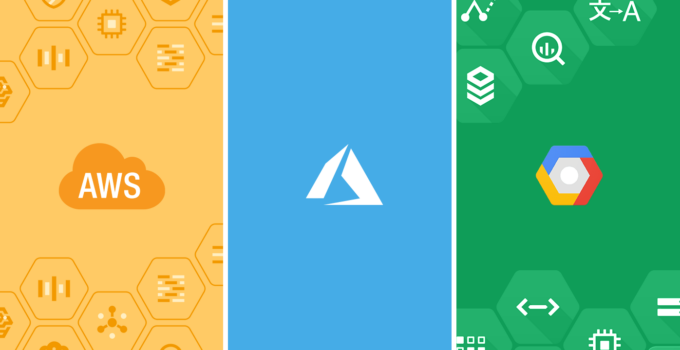What once seemed like a fad, the cloud computing industry reached a value worth USD 368.97 billion in 2025 and it is expected to grow at a CAGR of 15.7% through 2030 according to Grand View Research.
The ability to scale and pay-for-what-you-need pricing, make cloud technology a no-brainer for businesses of all sizes. On the other hand, with so many cloud service providers and services available, it can be difficult for organizations to figure out which option is best for their needs.
There are three primary cloud providers: Amazon Web Services (AWS), Microsoft Azure and Google Cloud Platform (GCP). All these platforms have their pros and cons, so it’s not always clear which one will be best for your project.
To help you decide which clouds are best for your business, let’s take a look at each of the big players: AWS vs. Azure vs. Google Cloud.
An Overview of AWS, Azure, and Google Cloud

Source: insights.dice.com
AWS
The first major player in the cloud computing space, AWS launched in 2006 and has dominated the market for years. AWS offers more than 200 different services, including compute, storage, networking, database and analytics to meet various demands. Users can pick from these solutions to run their applications/businesses and can pay by the hour or second with no long-term commitments. AWS also has a free tier for users who just want to try it out.
Azure
Microsoft’s cloud solution was initially seen as a distant second place to AWS, but has made a lot of progress in recent years. It launched as Windows Azure in 2010 and on March 25, 2014, it was renamed to Microsoft Azure. Microsoft describes Azure as a solution that allows you to “Build, run, distribute, and help secure your apps and games at global scale.” Azure offers more than 200 services to its customers in a number of areas including compute, storage and databases.
Google Cloud
Google Cloud Platform enters the battle with a relative paucity of features compared to the other two major cloud providers – at least on the surface. But while it lacks the sheer number of offerings of AWS or Azure, Google Cloud has grown rapidly in recent years as it builds out its infrastructure to support not only its public cloud but also Google’s massive internal operations.
Each of these companies has a different approach to their cloud products and services, but they all share an increasing focus on machine learning and artificial intelligence (AI) services.
Differences between AWS, Azure, and Google Cloud Compute Services

Source: proofpoint.com
For starters, you should become familiar with the capabilities of each cloud provider.
Here’s a breakdown of the main differences between them:
- Amazon Web Services (AWS): AWS is currently the leader in Infrastructure as a Service (IaaS). It was one of the first IaaS providers available, and its lead has grown in step with its customer base.
- Microsoft Azure: The primary benefit of Azure is that it works especially well for Windows-based services. If your company is already heavily invested in Windows platforms or if you’re looking to migrate to a Windows-based environment, Azure could be a great option.
- Google Cloud Platform: GCP has established itself as a strong player in IaaS, PaaS and hybrid cloud services, especially when it comes to data analytics and machine learning.
AWS vs. Azure vs. Google Cloud Market Share
According to Statista, as of Q4 2025, Amazon Web Services (AWS) is the king of cloud infrastructure services, owning 33% percent of the market, Microsoft Azure is second with 22% share, and Google Cloud a distant third with 9%.

Source: ccbtechnology.com
Compute services
AWS
AWS provides multiple options for both persistent and ephemeral compute instances. This includes virtual machines, containers, serverless compute, and bare metal. Services include: (Elastic Compute Cloud) EC2, Elastic Container Service for Kubernetes, Elastic Container Registry, and Lightsail, AWS Lambda, AWS Fargate, VMware Cloud on Amazon web services. Learn more about what AWS is , how it works and what benefits AWS can provide for your Business.
Azure
Like AWS, Azure offers a wide range of compute options. Virtual machines are available in both Windows and Linux, containers can run on either Docker or Kubernetes, serverless is handled by Azure Functions. Other compute solutions include Service Fabric, Google Cloud, Compute Engine, Kubernetes, etc.
Google Cloud
GCP has fewer options than the other two providers but still covers the essentials. Virtual machines are available in a variety of instance types, including custom machine types.
GCP provides Compute Engine, which offers similar functionality as AWS EC2 and Azure VMSS. GCP also offers several other products such as App Engine, Container Security, Graphics Processing Unit (GPU), Knative and Cloud Functions that are similar in scope to Azure Functions.
Storage — What types of storage are available with each provider?
AWS offers block, file and object storage, which can be used by applications to store data. Amazon Simple Storage Service (Amazon S3) is an example of the object storage that AWS provides. Amazon Elastic Block Store (Amazon EBS) provides block storage; this type of storage creates virtual hard disks that can be used by Amazon EC2 instances. AWS also offers file-based storage through its Elastic File System service. Others are Storage Gateway, Snowball Edge, and Snowmobile.
Azure provides Blob Storage for object storage, Disk Storage, Queue Storage, File Storage (aka SMB file shares), and Data Lake Storage.
GCP provides Google Cloud Storage which is similar to S3 but also has an archive class similar to AWS Glacier. Other storage services include Persistent Disk, Transfer Appliance, and Transfer Service.
AWS vs. Azure vs. Google Cloud: Comparing Cloud regions and availability

Source: altronkarabina.com
You can’t talk about the leading public cloud providers without eventually discussing their global footprint. But it’s not a simple matter of who has the most regions or availability zones, or even how they count them.
When comparing clouds, it’s often useful to compare the number of regions offered. Regions are locations where cloud services are located and include one or more data centers that are located physically close to other IT services.
At the time of writing, Microsoft Azure is the clear winner in terms of region, with 60+ followed by Google Cloud with 29 regions worldwide, while AWS has 26 regions.
Meanwhile, in terms of availability zones Azure has 3 supporting each region (so clearly they lead here too), Google Cloud has 88, and AWS 84.
How AWS, Azure, and Google Cloud differ in pricing
When it comes to pricing models, there are more similarities than differences between the three cloud providers. All three charge based on some combination of usage, customer requirements, and the services used.
At the very heart of it, these services are competitively priced and allow you to “pay as you go” – you only pay for what you use, and with no upfront commitment.
As to which is cheaper between AWs, Azure, and Google Cloud, it is a bit tricky to answer. However, there seems to be a general sentiment that Azure is cheapest, followed by AWS, while Google Cloud is the most costly. Yet again, remember, the numbers aren’t always apples to apples, but this should give you a general idea.
Pros and Cons of AWS, Azure, and Google Cloud

Source: rackspace.com
AWS
Pros
- Wide range of services
- The compute power AWS provides is greater than what Azure and Google Cloud provides
- It is compatible with most third-party software/services
- It is the most mature of the 3
Cons
- It is not the most suitable for Hybrid Cloud solutions
- The number of services can intimidate new users
Azure
Pros
- It also feature a wide and eclectic range of services
- Strong Machine Learning and AI solutions
- It boasts better hybrid cloud capabilities
- Less expensive than the other 2.
Cons
- Designed especially for businesses (enterprises)
Google Cloud
Pros
- Has the highest number of cloud regions and availability zones
- Integrates well with other Google products/services.
Cons
- Compared to Azure and AWS it has limited services
- Not particularly suited for enterprise projects.







